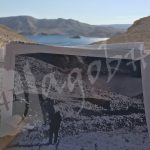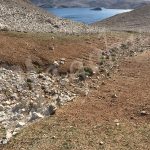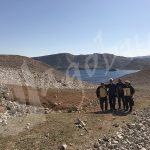
A two-day expedition was organized recently by the Association „Jadovno 1941“ from Banja Luka with the aim to locate the site on the island of Page where the Ustashas, soldiers of the Independent State of Croatia (NDH), slaughtered 91 children under the age of fifteen, 293 women and 407 men in the night between 14 and 15 August, 1941.
The members of the expedition had only few photographs taken by Italian soldiers in early September 1941 and scarce written material which only roughly describes the location of the execution site.
However, a photograph from the same time period taken from the very location of the execution site, which recently arrived to the Association from Italy and which shows a wider area around the location, was crucial for making the decision on a field expedition.
Great help in locating the execution site was provided by a local man; a good man with good knowledge on the area, who did not give up the search even when it seemed that the mission would be unsuccessful.
Antrifile
Only when you arrive to the location of the crime can you have some notion of how difficult and arduous path did the victims take, walking for almost two kilometres over the rocky desert from the Slana Camp to the location where they were tortured and murdered.
After climbing a difficult and steep terrain, at around 300 metres from the sea, not far from the Malin Cove, the team reached a small plateau with a small inclination where they could see the identical landscape as on the 76-year-old photograph.
Although the nature took its course since the summer of 1941, on this location, sixty metres from the edge of the Fornaža high plateau on the north, you can clearly see traces of a fifty-metre-long trench and several other, twenty-metre-long side trenches where 791 victims was murdered.
Only when you arrive to the location of the crime can you have some notion of how difficult and arduous path did the victims take, walking for almost two kilometres over the rocky desert from the Slana Camp to the location where they were tortured and murdered. It was also not easy for the women and children who were transported from the Metajna Camp in boats to the cove and then had to make a half kilometre steep climb to the trenches.
The members of the expedition took a series of photographs and videos, and the location and the route taken to reach it were recorded with a GPS device.
The crime was committed on this location on the eve of the Catholic holiday Assumption of Mary in 1941, when the Ustasha criminals intended to murder all remaining camp inmates before the Italian troops closed the camps Slana and Metajna.
The next morning, after the Ustasha criminals finished their bloody feast, drunk and with blood on their uniforms, they joined the procession on the streets of the town of Pag to the Catholic church in the town centre.
Due to the strong smell of decomposing bodies and fearing that drinking water might get contaminated, Italian military medical personnel exhumed the bodies twenty days after the crime, burned the corpses and buried the ashes and burnt remains back in the same trenches where the victims were murdered.
Antrifile
The memorial plaque at the Slana Bay was placed in 1975, smashed in 1991, and those that were renewed in 2010 and 2013 were smashed only few days later.
Since the terrain of the Slana Cape is rich with underground waters that spring out and flow towards the sea during rainy periods, the ashes and the remains of burned bodies have been moving for last eight decades towards the blue tomb of the Paška Vrata Channel where most of at least 8,020 victims were murdered on this Croatian in the summer of 1941.
Today, at the island of Pag at the location of the former camp, there is no monument that would remind people on the terrible fate of innocent victims, Serbs and Jews. The memorial plaque at the Slana Bay was placed in 1975, smashed in 1991, and those that were renewed in 2010 and 2013 were smashed only few days later.
In June 2015, the descendants of the victims gathered around the Association Jadovno 1941, placed and consecrated the Holy Cross at the location of the former Slana Camp, on the hill between the Serbian and the Jewish camp.
Dušan J. Bastašić
President of the Association Jadovno 1941







